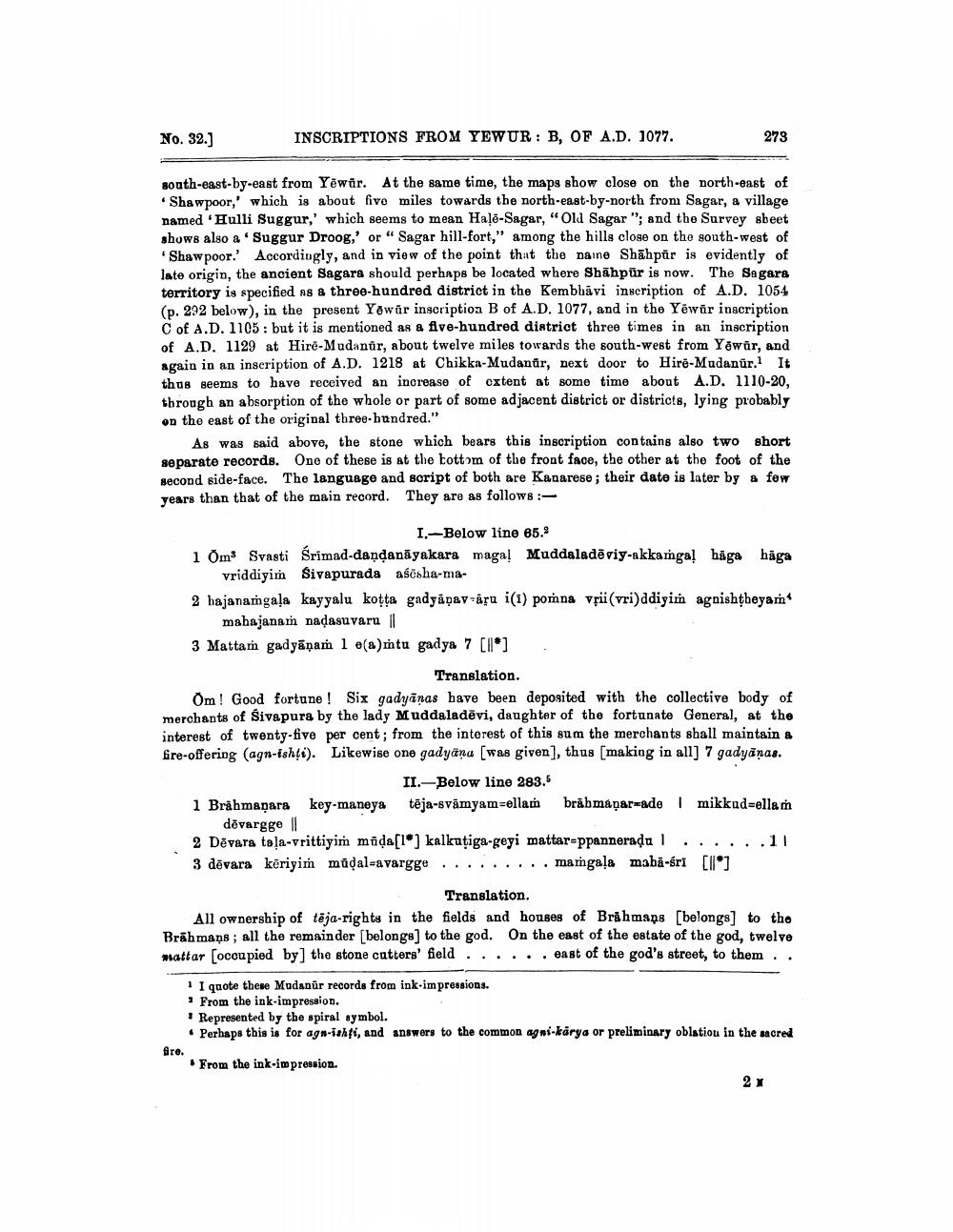________________
No. 32.)
INSCRIPTIONS FROM YEWUR: B, OF A.D. 1077.
273
south-east-by-east from Yēwar. At the same time, the maps show close on the north-east of
Shawpoor,' which is about five miles towards the north-east-by-north from Sagar, a village named 'Hulli Suggur,' which seems to mean Hale-Sagar, “Old Sagar"; and the Survey sbeet shows also a 'Suggur Droog,' or “ Sagar hill-fort," among the hills close on the south-west of
Shaw poor.' Accordingly, and in view of the point that the naine Shāhpur is evidently of late origin, the ancient Sagara should perhaps be located where Shāhpür is now. The Sagara territory is specified ng a three-hundred district in the Kembhavi inscription of A.D. 1054 (p. 292 below), in the present Yowür inscriptioa B of A.D. 1077, and in the Yewar inscription C of A.D. 1105: but it is mentioned as a five-hundred district three times in an inscription of A.D. 1129 at Hiro-Mudanür, about twelve miles towards the south-west from Yawar, and again in an inscription of A.D. 1218 at Chikka-Mudanár, next door to Hire-Mudanür. It thus seems to have received an increase of extent at some time about A.D. 1110-20, through an absorption of the whole or part of some adjacent district or districts, lying probably on the east of the original three-bundred."
As was said above, the stone which bears this inscription contains also two short separate records. One of these is at the tottom of the front face, the other at the foot of the second side-face. The language and script of both are Kanarese; their date is later by a few years than that of the main record. They are as follows:
I.-Below line 65. 1 Om Svasti Srimad-dandanāyakara maga! Muddaladēviy-akkarga! häga häga
vriddiyim Sivapurada asosha-ma2 hajanangala kayyalu koţta gadyāpav-āļu i(1) pomna vșiivri)ddiyim agnishthegam
mahajanam nadasuvaru || 3 Mattam gadyānam 1 e(a)itu gadya 7 [II]
Translation. Om! Good fortune! Six gadyānas have been deposited with the collective body of merchants of Sivapura by the lady Muddaladēvi, daughter of the fortunate General, at the interest of twenty-five per cent; from the interest of this sum the merchants shall maintain & bre-offering (agn-ishti). Likewise one gadyāna (was given], thus (making in all] 7 gadyanas.
II.-Below line 283.5 1 Brahmaṇara key-maneya tēja-svāmyam-ellam brābmaņar=ade m ikkud=ellam
dēvargge
2 Dēvara taļa-vrittiyim mida[l*) kalkatiga-geyi mattar-ppanneradul ......11 3 dēvara kēriyim müdal-avargge ......... mamgala mabă-śri [ll]
Translation. All ownership of tēja-rights in the fields and houses of Brahmaps [belongs to the Brāhmans; all the remainder [belongs to the god. On the east of the estate of the god, twelve mattar (ocoupied by] the stone catters' field...... east of the god's street, to them. .
1 I quote these Mudanur records from ink-impressions. ? From the ink-impression. • Represented by the spiral symbol.
. Perhaps this is for agw-ishti, and answers to the common agni-karya or preliminary oblatiou in the sacred Bre. From the ink-impression.
2x




